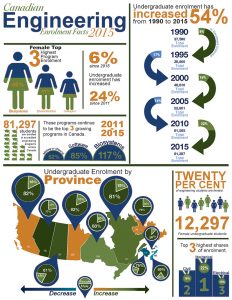Engineers Canada reports on student enrolment and graduations from Canadian universities and colleges. Data from 2015 show that undergraduate enrolment continues to increase year after year, a welcome trend for those of us who hire from these programs. This year’s newly capped and gowned crop of university students have wrapped up exams and are moving into the world or continuing their studies. The University of Toronto’s (U of T) Tyler Irving has written about a group of engineers who have been identified as future leaders for exhibiting “values of creativity, innovation and global impact.” Of those, the following are doing research that will likely influence regenerative medicine. Thank you to U of T for allowing Signals to share the content below.

Stephanie Gaglione (Photo: Marit Mitchell)
For Stephanie Gaglione, U of T Engineering has been about reaching outside her comfort zone. “Every class, extracurricular activity and sport has required some degree of risk-taking, new perspective or challenge,” she says.
Gaglione has completed internships in vaccine and drug development at Sanofi Pasteur and in business at Procter and Gamble, and spent a year on exchange at one of the world’s largest and most prolific biomedical research groups, run by Professor Robert Langer at the Massachusetts Institute of Technology (MIT). She also worked for two years on a project with the World Health Organization — including three months in Geneva — analyzing data from immunization programs. In her final year, she worked with Professor Cathy Chin (ChemE) and mentors at NASA to design an innovative reactor system to convert gaseous carbon dioxide into higher-order chemical compounds for long-term space missions.
In between all of these projects, Gaglione found time to compete on the Varsity Figure Skating and Nordic Skiing teams, and to take on leadership positions with the You’re Next Career Network, the Engineering Society and the university’s Governing Council. Her next move will be to the University of Oxford, where she will pursue an MSc in integrated immunology on a Rhodes Scholarship. Following that, she will pursue a PhD in Chemical Engineering at MIT.
“I hope to help develop the potential of customizable platforms that use the body’s own immune system to prevent and treat disease,” says Gaglione. “Vaccines, cancer immunotherapies, personalized tissue engineering, wound healing — the possibilities are endless.”

Serena Mandla. (Photo: Rick Lu)
Serena Mandla is already an established researcher, having published two papers — with two more in preparation — on work she did during her PEY internship in Ali Khademhosseini’s lab at Harvard Medical School. One of her projects involved the creation of an electrically conductive bioink for 3D printers. This material could be used to make scaffolds for growing heart cells and tissues outside the body, and may one day lead to lab-grown cardiac patches to repair hearts damaged by disease or injury.
Mandla believes strongly in giving back to her community. For the past three years, she has been both a frosh leader and a mentor for NSight, a program that connects first-year students with upper-year students to assist in the transition from high school to university. Last year, Mandla co-directed the program.
After graduation, Mandla will pursue an MASc, studying under Professor Milica Radisic (IBBME, ChemE). “I hope to continue working in the field of biomedical engineering, and eventually move into a leadership position within industry,” she says. “More importantly, I hope that I can inspire and motivate young women to pursue degrees and careers in the STEM fields.”

Edem Dovlo with her advanced medical imaging system. (Photo: Tyler Irving)
Studying under Professor Andreas Mandelis (MIE), Edem Dovlo designed new medical imaging systems that combine photoacoustic radar with traditional ultrasound. The advanced technique can detect cancer tumours at a much earlier stage than current techniques, and can even provide information on how malignant the cancer is likely to be. This in turn could lead to earlier interventions and better survival rates.
“My experience in MIE has been greatly shaped by the people here,” says Dovlo. “Having an experienced and knowledgeable supervisor who challenges his students and treats us with respect is a key part of that. The more I learn, the more I realize how much more there is to discover.”
In addition to publishing several papers on her work, Dovlo served as a Project Manager for 1Room, a Kenya-based, community-focused project that leverages technology and evidence to make high-quality schooling affordable and accessible to underserved populations. After graduation, she plans to work either in Canada or her native Ghana. “I am eager to incorporate the expertise acquired in my combined experiences to my future endeavours,” she says. “I do not know what the future holds but I am optimistic.”
Stacey Johnson
Latest posts by Stacey Johnson (see all)
- Right Turn: Season’s greetings and upcoming event - December 25, 2025
- Right Turn: Stem cell supplements: A growing market with growing risks - December 19, 2025
- Right Turn: Beyond the ’stache: The science, the progress, the promise - November 26, 2025







Comments